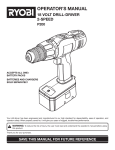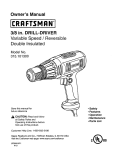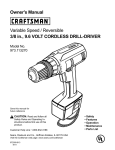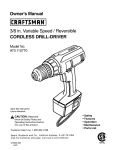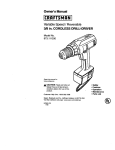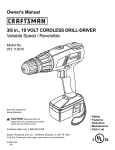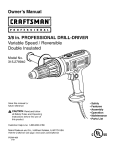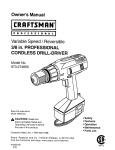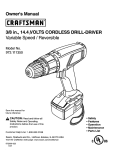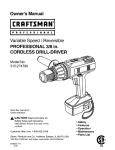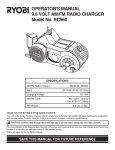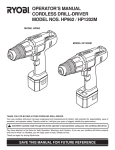Download Ryobi HP722 Operator`s manual
Transcript
OPERATOR'S MANUAL CORDLESS DRILL-DRIVER MODEL NOS. HP62 / HP722 MODEL HP62 5 10 5 10 MODEL HP722 THANK YOU FOR BUYING A RYOBI CORDLESS DRILL-DRIVER. Your new cordless drill-driver has been engineered and manufactured to Ryobi’s high standard for dependability, ease of operation, and operator safety. Properly cared for, it will give you years of rugged, trouble-free performance. CAUTION: Carefully read through this entire operator’s manual before using your new cordless drill-driver. Pay close attention to the Rules for Safe Operation, Warnings, and Cautions. If you use your cordless drill-driver properly and only for what it is intended, you will enjoy years of safe, reliable service. Thank you again for buying Ryobi tools. SAVE THIS MANUAL FOR FUTURE REFERENCE TABLE OF CONTENTS ■ General Safety Rule ................................................................................................................................................ 2-3 ■ Specific Safety Rules/Symbols ................................................................................................................................ 3-5 ■ Features .................................................................................................................................................................. 5-7 ■ Operation ............................................................................................................................................................... 8-14 ■ Maintenance ............................................................................................................................................................. 15 ■ Battery Removal ....................................................................................................................................................... 16 ■ Parts Ordering / Service ........................................................................................................................................... 18 GENERAL SAFETY RULES Personal Safety WARNING: ■ Read and understand all instructions. Failure to follow all instructions listed below, may result in electric shock, fire and/or serious personal injury. SAVE THESE INSTRUCTIONS Work Area ■ ■ Keep your work area clean and well lit. Cluttered benches and dark areas invite accidents. ■ Do not operate power tools in explosive atmospheres, such as in the presence of flammable liquids, gases, or dust. Power tools create sparks which may ignite the dust or fumes. ■ Keep bystanders, children, and visitors away while operating a power tool. Distractions can cause you to lose control. Electrical Safety ■ ■ ■ Do not abuse the cord. Never use the cord to carry the charger. Keep cord away from heat, oil, sharp edges, or moving parts. Replace damaged cords immediately. Damaged cords may create a fire. ■ A battery operated tool with integral batteries or a separate battery pack must be recharged only with the specified charger for the battery. A charger that may be suitable for one type of battery may create a risk of fire when used with another battery. Use battery only with charger listed. ■ ■ MODEL BATTERY CHARGER HP62 HP722 N/A 1311145 7224301 7222701 ■ Use battery operated tool only with specifically designated battery pack. Use of any other batteries may create a risk of fire. Use only with battery pack listed. Page 2 Stay alert, watch what you are doing and use common sense when operating a power tool. Do not use tool while tired or under the influence of drugs, alcohol, or medication. A moment of inattention while operating power tools may result in serious personal injury. Dress properly. Do not wear loose clothing or jewelry. Contain long hair. Keep your hair, clothing, and gloves away from moving parts. Loose clothes, jewelry, or long hair can be caught in moving parts. Avoid accidental starting. Be sure switch is in the locked or off position before inserting battery pack. Carrying tools with your finger on the switch or inserting the battery pack into a tool with the switch on, invites accidents. Remove adjusting keys or wrenches before turning the tool on. A wrench or a key that is left attached to a rotating part of the tool may result in personal injury. Do not overreach. Keep proper footing and balance at all times. Proper footing and balance enable better control of the tool in unexpected situations. Do not use on a ladder or unstable support. Use safety equipment. Always wear eye protection. Dust mask, nonskid safety shoes, hard hat, or hearing protection must be used for appropriate conditions. GENERAL SAFETY RULES ■ Tool Use and Care ■ ■ ■ ■ ■ ■ Use clamps or other practical way to secure and support the workpiece to a stable platform. Holding the work by hand or against your body is unstable and may lead to loss of control. Do not force tool. Use the correct tool for your application. The correct tool will do the job better and safer at the rate for which it is designed. Do not use tool if switch does not turn it on or off. A tool that cannot be controlled with the switch is dangerous and must be repaired. Disconnect battery pack from tool before making any adjustments, changing accessories, or storing the tool. Such preventive safety measures reduce risk of starting the tool accidentally. Store idle tools out of reach of children and other untrained persons. Tools are dangerous in the hands of untrained users. When battery pack is not in use, keep it away from other metal objects like: paper clips, coins, keys, nails, screws, or other small metal objects that can make a connection from one terminal to another. Shorting the battery terminals together may cause sparks, burns, or a fire. ■ ■ Maintain tools with care. Keep cutting tools sharp and clean. Properly maintained tools, with sharp cutting edges are less likely to bind and are easier to control. Check for misalignment or binding of moving parts, breakage of parts, and any other condition that may affect the tool's operation. If damaged, have the tool serviced before using. Many accidents are caused by poorly maintained tools. Use only accessories that are recommended by the manufacturer for your model. Accessories that may be suitable for one tool, may create a risk of injury when used on another tool. Service ■ ■ Tool service must be performed only by qualified repair personnel. Service or maintenance performed by unqualified personnel could result in a risk of injury. When servicing a tool, use only identical replacement parts. Follow instructions in the Maintenance section of this manual. Use of unauthorized parts or failure to follow Maintenance Instructions may create a risk of shock or injury. SPECIFIC SAFETY RULES AND/OR SYMBOLS Hold tool by insulated gripping surfaces when performing an operation where the cutting tool may contact hidden wiring. Contact with a "live" wire will make exposed metal parts of the tool "live" and shock the operator. Additional Rules For Safe Operation ■ ■ Know your power tool. Read operator's manual carefully. Learn its applications and limitations, as well as the specific potential hazards related to this tool. Following this rule will reduce the risk of electric shock, fire, or serious injury. Make sure your extension cord is in good condition. When using an extension cord, be sure to use one heavy enough to carry the current your product will draw. A wire gage size (A.W.G.) of at least 16 is recommended for an extension cord 100 feet or less in length. A cord exceeding 100 feet is not recommended. If in doubt, use the next heavier gage. The smaller the gage number, the heavier the cord. An undersized cord will cause a drop in line voltage resulting in loss of power and overheating. ■ ■ ■ ■ Important Rules for Battery Tools ■ Battery tools do not have to be plugged into an electrical outlet; therefore, they are always in operating condition. Be aware of possible hazards when Page 3 not using your battery tool or when changing accessories. Following this rule will reduce the risk of electric shock, fire, or serious personal injury. Do not place battery tools or their batteries near fire or heat. This will reduce the risk of explosion and possibly injury. Do not charge battery tool in a damp or wet location. Following this rule will reduce the risk of electric shock. For best results, your battery tool should be charged in a location where the temperature is between 50 and 100°F. Under extreme usage or temperature conditions, battery leakage may occur. If liquid comes in contact with your skin, wash immediately with soap and water, then neutralize with lemon juice or vinegar. If liquid gets into your eyes, flush them with clean water for at least 10 minutes, then seek immediate medical attention. Following this rule will reduce the risk of serious personal injury. SPECIFIC SAFETY RULES AND/OR SYMBOLS ■ Important Safety Instructions For Charger ■ ■ ■ ■ ■ ■ ■ ■ ■ Save these instructions. This manual contains important safety and operating instructions for charger. Following this rule will reduce the risk of electric shock, fire, or serious personal injury. Before using battery charger, read all instructions and cautionary markings in this manual, on battery charger, and product using battery charger. Following this rule will reduce the risk of electric shock, fire, or serious personal injury. To reduce risk of injury, charge only nickel-cadmium and nickel metal hydride type rechargeable batteries. Other types of batteries may burst causing personal injury and damage. Following this rule will reduce the risk of electric shock, fire, or serious personal injury. Do not expose charger to rain or snow. Following this rule will reduce the risk of electric shock, fire, or serious personal injury. Use of an attachment not recommended or sold by the battery charger manufacturer may result in a risk of fire, electric shock, or injury to persons. Following this rule will reduce the risk of electric shock, fire, or serious personal injury. To reduce risk of damage to charger body and cord, pull by charger plug rather than cord when disconnecting charger. Following this rule will reduce the risk of electric shock, fire, or serious personal injury. Make sure cord is located so that it will not be stepped on, tripped over, or otherwise subjected to damage or stress. Following this rule will reduce the risk of serious personal injury. An extension cord should not be used unless absolutely necessary. Use of improper extension cord could result in a risk of fire and electric shock. If extension cord must be used, make sure: a. That pins on plug of extension cord are the same number, size and shape as those of plug on charger. b. That extension cord is properly wired and in good electrical condition; and c. That wire size is large enough for AC ampere rating of charger as specified below: Cord Length (Feet) 25' 50' 100' Cord Size (AWG) 16 16 16 Note: AWG = American Wire Gage Do not operate charger with a damaged cord or plug. If damaged, have replaced immediately by a qualified serviceman. Following this rule will reduce the risk of electric shock, fire, or serious personal injury. ■ ■ ■ Do not operate charger if it has received a sharp blow, been dropped, or otherwise damaged in any way; take it to a qualified serviceman. Following this rule will reduce the risk of electric shock, fire, or serious personal injury. Do not disassemble charger; take it to a qualified serviceman when service or repair is required. Incorrect reassembly may result in a risk of electric shock or fire. Following this rule will reduce the risk of electric shock, fire, or serious personal injury. To reduce the risk of electric shock, unplug charger from outlet before attempting any maintenance or cleaning. Turning off controls will not reduce this risk. Following this rule will reduce the risk of electric shock, fire, or serious personal injury. Disconnect charger from power supply when not in use. Following this rule will reduce the risk of electric shock, fire, or serious personal injury. DANGER: RISK OF ELECTRIC SHOCK. DO NOT TOUCH UNINSULATED PORTION OF OUTPUT CONNECTOR OR UNINSULATED BATTERY TERMINAL. ■ Page 4 Save these instructions. Refer to them frequently and use them to instruct others who may use this tool. If you loan someone this tool, loan them these instructions also. Following this rule will reduce the risk of electric shock, fire, or serious personal injury. WARNING: Some dust created by power sanding, sawing, grinding, drilling, and other construction activities contains chemicals known to cause cancer, birth defects or other reproductive harm. Some examples of these chemicals are: • lead from lead-based paints, • crystalline silica from bricks and cement and other masonry products, and • arsenic and chromium from chemically-treated lumber. Your risk from these exposures varies, depending on how often you do this type of work. To reduce your exposure to these chemicals: work in a well ventilated area, and work with approved safety equipment, such as those dust masks that are specially designed to filter out microscopic particles. SYMBOLS SYMBOL NAME DESIGNATION/EXPLANATION V Volts Voltage A Amperes Current Hz Hertz Frequency (cycles per second) min Minutes Time Alternating Current Type or a characteristic of current --- Direct Current Type or a characteristic of current n0 No Load Speed Rotational speed, at no load .../min Revolutions or Reciprocation Per Minute Revolutions, strokes, surface speed, orbits etc. per minute Safety Alert Symbol Indicates danger, warning or caution. It means attention!!! Your safety is involved. FEATURES DEFINITIONS A) DANGER: Failure to obey a safety warning will result in serious injury to yourself or to others. Always follow the safety precautions to reduce the risk of fire, electric shock and personal injury. B) WARNING: Failure to obey a safety warning can result in serious injury to yourself or to others. Always follow the safety precautions to reduce the risk of fire, electric shock and personal injury. C) CAUTION: Failure to obey a safety warning may result in property damage or personal injury to yourself or to others. Always follow the safety precautions to reduce the risk of fire, electric shock and personal injury. D) NOTE: Advises you of information or instructions vital to the operation or maintenance of the equipment. WARNING: The operation of any power tool can result in foreign objects being thrown into your eyes, which can result in severe eye damage. Before beginning power tool operation, always wear safety goggles or safety glasses with side shields and a full face shield when needed. We recommend Wide Vision Safety Mask for use over eyeglasses or standard safety glasses with side shields. Always wear eye protection which is marked to comply with ANSI Z87.1. Page 5 FEATURES PRODUCT SPECIFICATIONS: DRILL-DRIVER HP62 HP722 Chuck 3/8 in. Keyless 3/8 in. Keyless Motor DC Motor 6.0 Volt DC Motor 7.2 Volt Switch Two Speed Two Speed No Load Speed 300 - 500 RPM 330 - 500 RPM Clutch 24 Positions 24 Positions Charger Input 120 V, 60 Hz, AC only 120 V, 60 Hz, AC only Charge Rate 3-6 Hours 3-6 Hours SWITCH KNOW YOUR DRILL-DRIVER See Figure 1. To turn your drill-driver ON, depress the switch trigger. Release switch trigger to turn your drill-driver OFF. Before attempting to use your drill-driver, familiarize yourself with all operating features and safety requirements. SWITCH LOCK The switch trigger can be locked in the OFF position. This feature helps reduce the possibility of accidental starting when not in use. WARNING: Carefully read through this entire operator's manual before using your new drill-driver. Pay close attention to the Rules For Safe Operation, Warnings and Cautions. If you use your drill-driver properly and only for what it is intended, you will enjoy years of safe, reliable service. TWO SPEED SWITCH Your drill has a two speed feature in the switch. Depress the switch trigger halfway for driving screws at a low speed. Depress the switch trigger all the way for normal drilling. FORWARD/REVERSE SELECTOR (DIRECTION OF ROTATION SELECTOR) WARNING: Do not allow familiarity with your drill-driver to make you careless. Remember that a careless fraction of a second is sufficient to inflict severe injury. KEYLESS CHUCK Your drill-driver has a keyless chuck that allows you to hand tighten or release drill bit in the chuck jaws. Your drill-driver has a forward/reverse selector located above the switch trigger. BIT STORAGE When not in use, bits provided with your drill-driver can be placed in the storage area located on the top of the motor housing. LEVEL To keep drill bit level during drilling operations, a level is located on the top end of the motor housing. Page 6 FEATURES MODEL HP62 LEVEL TORQUE ADJUSTMENT RING BIT STORAGE AREA 5 10 DIRECTION OF ROTATION SELECTOR KEYLESS CHUCK SWITCH TRIGGER Fig. 1 MODEL HP722 LEVEL 10 TORQUE ADJUSTMENT RING 5 BIT STORAGE AREA DIRECTION OF ROTATION SELECTOR SWITCH TRIGGER KEYLESS CHUCK BATTERY PACK Fig. 1a Page 7 OPERATION CHARGING YOUR DRILL-DRIVER This tool has been shipped in a low charge condition to prevent possible problems. Therefore, you should charge it overnight prior to use. Note: Batteries will not reach full charge the first time they are charged. Allow several cycles (drilling followed by recharging) for them to become fully charged. TO CHARGE MODEL HP62 ■ ■ ■ ■ MODEL HP62 CHARGER CHARGE INDICATOR LIGHT (LED) Charge only with the charger provided. Connect charger to the tool by inserting charger plug into input jack. Note: As shown in figure 2, input jack is located at rear of tool. Make sure power supply is normal household voltage, 120 volts, 60 Hz, AC only. Connect charger to power supply. INPUT JACK CHARGER PLUG TO CHARGE MODEL HP722 ■ ■ Charge only with the charger provided. Connect charger to the battery pack by inserting charger plug into input jack. Note: As shown in figure 3, input jack is located at rear of battery pack. Note: Battery pack for Model HP722, can be removed from the drill to be charged. See Figure 3. To remove battery pack from drill, follow instructions on page 9. ■ Make sure power supply is normal household voltage, 120 volts, 60 Hz, AC only. ■ Connect charger to power supply. MODEL HP62 AND HP722 ■ The charge indicator light (LED) indicator, which is located on rear of drill, will light up when charger is properly connected to power supply. This red light indicates your battery is charging and will remain on until charger is disconnected from power supply. Note: During the two year warranty period on drill Model HP722, if the charge indicator light (LED) fails to come on or goes out while charging battery pack, return charger and battery pack to your nearest authorized service center for repair or replacing. If you have drill Model HP62, return charger to service center. ■ After normal usage, 3 hours or less of charging time is required to fully recharge battery pack. Note: If battery pack is completely discharged, 6 hours or longer of charging time is required to fully recharge battery pack. ■ The charger housing and the tool handle will become slightly warm to the touch while charging. This is normal and does not indicate a problem. ■ DO NOT operate drill while it is connected to the charger. The driving ability will not increase. ■ DO NOT place charger in an area of extreme heat or cold. It works best at normal room temperature. ■ When battery pack has been charged, disconnect charger from power supply. This practice will increase battery life. Page 8 Fig. 2 MODEL HP722 BATTERY PACK CHARGER INPUT JACK CHARGE INDICATOR LIGHT (LED) BATTERY PACK CHARGER INPUT JACK CHARGER PLUG CHARGE INDICATOR LIGHT (LED) Fig. 3 OPERATION IMPORTANT INFORMATION FOR RECHARGING HOT BATTERIES DIRECTION OF ROTATION SELECTOR When using your drill-driver continuously, the batteries become hot. You should let the batteries cool down for approximately 30 minutes before attempting to recharge. Note: This situation occurs when continuous use of your drilldriver causes the batteries to become hot. It does not occur under normal circumstances. Refer to "Charging Your DrillDriver" for normal recharging of batteries. If the charger does not charge your batteries under normal circumstances, return both the drill-driver and charger to your nearest AUTHORIZED SERVICE CENTER for electrical check. For more information on the battery recycling call 1-800-8 BATTERY. 53 10 REVERSE CENTER POSITION (LOCK) FORWARD SWITCH TRIGGER WARNING: If any parts are missing, do not operate tool until the missing parts are replaced. Failure to do so could result in possible serious personal injury. Fig. 4 MODEL HP722 10 5 SWITCH See Figure 4. Your drill starts and stops by depressing and releasing the switch trigger. Your drill has a two-speed feature in the switch. Depress the switch trigger halfway for driving screws at low speed. Depress the switch trigger all the way for normal drilling. Release the switch trigger to turn drill OFF. SWITCH LOCK See Figure 4. BATTERY PACK The switch trigger can be locked in the OFF position. This feature helps reduce the possibility of accidental starting when not in use. To lock the switch trigger, place the direction of rotation selector in the center position. BATTERY PORT TO INSTALL BATTERY PACK MODEL HP722 ■ ■ ■ Place the direction of rotation selector in center position. See Figure 4. Place the battery pack in your drill. Align raised rib on battery pack with groove in drill's battery port. See Figure 5. Make sure the latches on each side of your battery pack snap in place and that battery pack is secured in drill before beginning operation. LATCHES DEPRESS LATCHES TO RELEASE BATTERY PACK Fig. 5 TO REMOVE BATTERY PACK MODEL HP722 ■ ■ ■ Place the direction of rotation selector in center position. See Figure 4. Locate latches on side of battery pack and depress both sides to release battery pack from your drill. See Figure 5. Remove battery pack from your drill. CAUTION: When placing battery pack in your drill, be sure raised rib on battery pack aligns with groove in drill's battery port and latches snap in place properly. Improper assembly of battery pack can cause damage to internal components. Page 9 OPERATION DIRECTION OF ROTATION SELECTOR REVERSE 53 This tool is reversible. The direction of rotation is controlled by a selector located above the switch trigger. With the drill held in normal operating position, the direction of rotation selector should be positioned to the left of the switch for drilling. The drilling direction is reversed when the selector is to the right of the switch. When the selector is in center position, the switch trigger is locked. 10 REVERSIBLE See Figure 6. CAUTION: To prevent gear damage, always allow chuck to come to a complete stop before changing the direction of rotation. CENTER POSITION (LOCK) FORWARD SWITCH TRIGGER To stop, release switch trigger and allow the chuck to come to a complete stop. WARNING: Fig. 6 Battery tools are always in operating condition. Therefore, switch should always be locked when not in use or when carrying at your side. RELEASE (UNLOCK) KEYLESS CHUCK A keyless chuck has been provided with your drill to allow for easy installation and removal of bits. As the name implies, you can hand tighten or release drill bits in the chuck jaws. Grasp and hold the collar of the chuck with one hand. Rotate the chuck body with your other hand. The arrows on the chuck indicate which direction to rotate the chuck body in order to GRIP (tighten) or RELEASE (unlock) the drill bit. WARNING: Do not hold the chuck body with one hand and use the power of the drill to tighten chuck jaws on drill bit. Chuck body could slip in your hand or your hand could slip and come in contact with rotating drill bit. This could cause an accident resulting in serious personal injury. Page 10 5 10 KEYLESS CHUCK See Figure 7. CHUCK BODY GRIP (TIGHTEN) CHUCK COLLAR Fig. 7 OPERATION INSTALLING BITS ■ Insert your drill bit into the chuck the full length of the jaws. See Figure 8. ■ Tighten the chuck jaws on the drill bit. To tighten, grasp and hold the collar of the chuck with one hand, while rotating the chuck body with your other hand. Note: Rotate the chuck body in the direction of the arrow marked GRIP to tighten the chuck jaws. DRILL BIT CHUCK COLLAR RIGHT Fig. 8 DO NOT use a wrench to tighten or loosen the chuck jaws. 0 1 ■ CHUCK BODY CHUCK JAWS 10 ■ Place the direction of rotation selector in center position. See Figure 4. This will turn off the power to your drill. Open or close the chuck jaws to a point where the opening is slightly larger than the bit size you intend to use. Also, raise the front of your drill slightly to keep the bit from falling out of the chuck jaws. 5 ■ WARNING: 5 Do not insert drill bit into chuck jaws and tighten as shown in figure 9. This could cause drill bit to be thrown from drill resulting in possible serious personal injury or damage to the chuck. REMOVING BITS See Figure 8. ■ ■ ■ ■ ■ Place the direction of rotation selector in center position. See Figure 4. This will turn off the power to your drill. Loosen the chuck jaws from drill bit. To loosen: grasp and hold the collar of the chuck with one hand, while rotating chuck body with your other hand. Note: Rotate chuck body in the direction of the arrow marked RELEASE to loosen chuck jaws. DO NOT use a wrench to tighten or loosen the chuck jaws. Remove drill bit from chuck jaws. Page 11 WRONG Fig. 9 OPERATION SCREWDRIVING TO DECREASE TORQUE 5 (Driving power of your drill-driver) When using your drill-driver for various driving applications, it becomes necessary to increase or decrease the torque in order to help prevent the possibility of damaging screw heads, threads, workpiece, etc. In general, torque should correspond to the intensity of the screw diameter. If the torque is too high or the screws too small, the screws may be damaged or broken. The torque is adjusted by rotating the torque adjustment ring. See Figure 10. The torque is greater when the torque adjustment ring is set on a higher setting. The torque is less when the torque adjustment ring is set on a lower setting. 10 TORQUE ADJUSTMENT TORQUE ADJUSTMENT RING TO INCREASE TORQUE The proper setting depends on the type of material and the size of screw you are using. Fig. 10 SCREWDRIVER BITS TO ADJUST TORQUE • 17 - 20 • 21 - 5 ■ Identify the twenty four torque indicator settings located on the front of your drill. See Figure 10. Rotate adjustment ring to the desired setting. • 1-4 For driving small screws. • 5-8 For driving screws into soft material. • 9 - 12 For driving screws into soft and hard materials. • 13 - 16 For driving screws in hard wood. 10 ■ BIT STORAGE AREA For driving large screws. For heavy drilling. Fig. 11 BIT STORAGE See Figure 11. When not in use, bits provided with your drill can be placed in the storage area located on the top of your drill as shown in figure 11. 20 LEVEL DRILLING See Figure 12. 20 A convenient new feature provided with your drill is a level. It is recessed in the motor housing on top of your drill. It can be used to keep drill bit level during drilling operations. LEVEL Fig. 12 Page 12 OPERATION WARNING: Always wear safety goggles or safety glasses with side shields when operating tool. Failure to do so could result in objects being thrown into your eyes, resulting in possible serious injury. DRILLING See Figure 13. 20 WARNING: 15 When drilling hard, smooth surfaces, use a center punch to mark the desired hole location. This will prevent the drill bit from slipping off center as the hole is started. However, the lower speed feature allows starting holes without center punching if desired. To accomplish this, simply operate your drill at lower speed until the hole is started. The material to be drilled should be secured in a vise or with clamps to keep it from turning as the drill bit rotates. Hold tool firmly and place the bit at the point to be drilled. Depress the switch trigger to start tool. Move the drill bit into the workpiece, applying only enough pressure to keep the bit cutting. Do not force or apply side pressure to elongate a hole. Fig. 13 Be prepared for binding or bit breakthrough. When these situations occur, the drill has a tendency to grab and kick opposite to the direction of rotation and could cause loss of control when breaking through material. If you are not prepared, this loss of control can result in possible serious injury. When drilling metals, use a light oil on the drill bit to keep it from overheating. The oil will prolong the life of the bit and increase the drilling action. If the bit jams in workpiece or if the drill stalls, release switch trigger immediately. Remove the bit from the workpiece and determine the reason for jamming. Page 13 OPERATION ■ ■ ■ Lock the switch trigger by placing the direction of rotation selector in center position. See Figure 4. Insert a 5/16 inch or larger hex key wrench into the chuck of your drill and tighten the chuck jaws securely. Tap the hex key wrench sharply with a mallet in a clockwise direction. See Figure 14. This will loosen the screw in the chuck for easy removal. Open chuck jaws and remove hex key wrench. Remove the chuck screw by turning it in a clockwise direction. MALLET KEYLESS CHUCK CHUCK JAWS 5 ■ 10 CHUCK REMOVAL See Figures 14, 15, and 16. See Figure 15. HEX KEY WRENCH The chuck may become loose on spindle and develop a wobble. To tighten, follow these steps: ■ Lock the switch trigger by placing the direction of rotation selector in center position. See Figure 4. ■ ■ Open the chuck jaws. Insert hex key wrench into chuck and tighten chuck jaws securely. Tap hex key wrench sharply with a mallet in a clockwise direction. This will tighten chuck on the spindle. Open the chuck jaws and remove hex key wrench. Tighten the chuck screw. Note: The chuck screw has left hand threads. Fig. 15 5 10 ■ ■ Fig. 14 5 TO RETIGHTEN A LOOSE CHUCK 10 ■ Note: The screw has left hand threads. Insert hex key wrench in chuck and tighten chuck jaws securely. Tap sharply with a mallet in a counterclockwise direction. This will loosen chuck on the spindle. It can now be unscrewed by hand. See Figure 16. Fig. 16 Page 14 MAINTENANCE BATTERIES Your drill is equipped with Nickel-Cadmium rechargeable batteries. Length of service from each charging will depend on the type of work you are doing. The batteries in this tool have been designed to provide maximum trouble-free life. However, like all batteries, they will eventually wear out. See Page 16 for DISPOSAL OF EXHAUSTED BATTERIES. Do not disassemble your drill or battery pack. To obtain the longest possible battery life, we suggest the following: ■ Store and charge your batteries in a cool area. Temperatures above normal room temperature will shorten battery life. ■ Never store batteries in a discharged condition. Wait for the batteries to cool and charge immediately. ■ All batteries gradually lose their charge. The higher the temperature, the quicker they lose their charge. If you store your tool for long periods of time without using it, recharge the batteries every month or two. This practice will prolong battery life. DO NOT ABUSE POWER TOOLS. Abusive practices can damage the tool, as well as the work piece. WARNING: When servicing use only identical replacement parts. Use of any other parts may create a hazard or cause product damage. Avoid using solvents when cleaning plastic parts. Most plastics are susceptible to damage from various types of commercial solvents and may be damaged by their use. Use a clean cloth to remove dirt, oil, grease, etc. WARNING: Do not attempt to modify this tool or create accessories not recommended for use with this tool. Any such alteration or modification is misuse and could result in a hazardous condition leading to possible serious personal injury. WARNING: CAUTION: Do not at any time let brake fluids, gasoline, petroleumbased products, penetrating oils, etc., come in contact with plastic parts. They contain chemicals that may damage, weaken, or destroy plastics. Any repairs requiring disassembly should only be performed by an AUTHORIZED SERVICE CENTER. For the repair center nearest you, call 1-800-525-2579. Page 15 BATTERY REMOVAL DISPOSAL OF EXHAUSTED BATTERIES C YC R ER B R CL E To preserve natural resources, please recycle or dispose of batteries properly. MODEL HP62 37 1.8 This product contains nickel-cadmium battery. Local, state, or federal laws may N i Cd prohibit disposal of Nickel-Cadmium 00 .822.88 batteries in ordinary trash. Consult your local waste authority for information regarding available recycling and/or disposal options. For more information on battery recycling call 1-800-8 BATTERY. DRILL HANDLE WARNING: Do not attempt to disassemble batteries. Fire or injury may result. BATTERY REMOVAL, PREPARATION FOR RECYCLING MODEL HP62 See Figures 17 and 18. TO REMOVE: ■ Lock switch trigger by placing the forward/reverse switch in center position. See Figure 4. ■ Remove battery cover from bottom of drill handle by depressing and pushing cover in the direction of the arrow as shown in figure 17. ■ Slide battery assembly from drill handle enough to expose leads and battery terminals. See Figure 18. Disconnect leads from battery terminals. Note: Be careful not to break battery terminals when disconnecting leads. TO REMOVE COVER BATTERY COVER Fig. 17 MODEL HP62 DRILL HANDLE BATTERY LEAD WARNING: Upon removal, cover the battery assemblies terminals with heavy duty adhesive tape. Do not attempt to destroy or disassemble battery assembly or remove any of its components. Also, never touch both terminals with metal objects and/or body parts, as short circuit may result. Keep away from children. Failure to comply with these warnings could result in fire and/or serious injury. BATTERY LEAD BATTERIES SAVE THESE INSTRUCTIONS Page 16 Fig. 18 NOTES Page 17 OPERATOR'S MANUAL CORDLESS DRILL-DRIVER MODEL NOS. HP62 / HP722 • SERVICE Now that you have purchased your tool, should a need ever exist for repair parts or service, simply contact your nearest Authorized Service Center. Be sure to provide all pertinent facts when you call or visit. Please call 1-800-525-2579 in the United States for your nearest Authorized Service Center. You can also check our web site at www.ryobitools.com for a complete list of Authorized Service Centers. • MODEL NO. AND SERIAL NO. The model number of this tool will be found on a plate attached to the motor housing. Please record the model number and serial number in the space provided below. • HOW TO ORDER REPAIR PARTS WHEN ORDERING REPAIR PARTS, ALWAYS GIVE THE FOLLOWING INFORMATION: • MODEL NUMBERS HP62 / HP722 • SERIAL NUMBERS RYOBI TECHNOLOGIES INC. 1428 Pearman Dairy Road Anderson, SC 29625 Post Office Box 1207 Anderson, SC 29622-1207 Phone 1-800-525-2579 972000-872 3-02


















